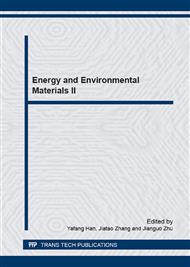p.418
p.425
p.430
p.435
p.441
p.447
p.458
p.464
p.470
Removal of Metal Ions from Aqueous Solutions by Microcapsules Prepared by 8-Hydroxy-Quinoline with Polystyrene
Abstract:
The removal of Fe3+, Cu2+,Cd2+,Cr3+ and Zn2+ ions from aqueous solution was studied by sorption onto polystyrene microcapsules containing 8-hydroxy-quinoline as extraction reagent. The micro-capsules containing 8-hydroxy-quinoline were prepared by solvent evaporation method with O/W emulsion and characterized by using optical microscope, Fourier Transform Infrared Spectroscopy (FT-IR). The uptake to Fe3+, Cu2+,Cd2+,Cr3+ and Zn2+ ions into the microcapsules was studied at deferent conditions. It showed that with the increasing dosage of microcapsules, the removal of metal ions increased too. The longer is standing time, the more is the increasing of adsorption capacity. The sorption of metal ions decreases with the initial pH of the solution increasing, and the sorption of microcapsule for metal ions is lower at 50°C. The sorption of Cr3+, Cu2+ and Zn2+ ions is highest at 45°C, and that of Fe3+, Cd2+ is at 40°C. The results showed that the microcapsules could absorb Cr3+ ions better than other metal ions.
Info:
Periodical:
Pages:
441-446
Citation:
Online since:
March 2015
Authors:
Keywords:
Price:
Сopyright:
© 2015 Trans Tech Publications Ltd. All Rights Reserved
Share:
Citation:


